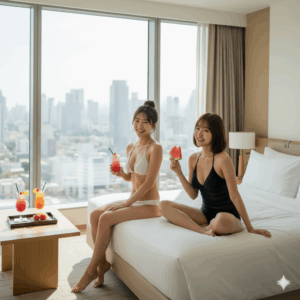Tokyo’s night is a network of small rooms: counter izakaya, private-room karaoke, basement clubs, and lounge floors perched above neon crossings. Spatially, venues cluster near stations and along pedestrian streets, with reception desks and ticket counters at street level and the main rooms set back or upstairs. Services follow predictable formats: izakaya offer seated drinks plus small appetizers (table charges vary by place), karaoke rents private rooms by time, and clubs sell timed entry with drink purchases at bars. Guests are mostly 20–50s, with a rising share of foreign visitors; multilingual menus and contactless payment are common. As a cultural system, Tokyo nightlife performs “staged intimacy”: standardized greetings and scripts, clear time units, and rules on IDs, smoking, and transit that keep a huge city’s night moving. This is a practical field guide to that system for readers searching for tokyo nightlife for foreigners.
1. Overview—where should you start in tokyo nightlife for foreigners?
2. Top Areas & Access—how do you reach the friendly zones fast?
3. Prices, Time & Eligibility—what does it cost and who can enter?
4. Venue Types & Services—what happens inside, by format?
5. Reservations, Etiquette & Useful Phrases—how to book and behave?
6. Summary and Next Steps—plan smart, stay safe, and enjoy
1. Overview—where should you start in tokyo nightlife for foreigners?

1-1 Area overview
For a first night, choose a dense district where venues are close and signage is bilingual. Shibuya’s club floor and small bars cluster around Center-gai and Dogenzaka; the ward tourism and city sites promote the area as a cultural hub. Conclusion: pick Shibuya if you want one-stop variety within 5–8 minutes on foot from the station—see the ward’s official visitor pages: 渋谷区観光協会(日本語) and the Tokyo metropolitan tourism portal’s Shibuya page (日本語).
1-2 Venue distribution
Shinjuku offers the broadest spectrum—counter pubs, karaoke towers, and big saunas—centered around Kabukicho. Conclusion: expect the highest venue density within 10 minutes of Shinjuku Station’s east side; reference the Shinjuku Convention & Visitors Bureau for district info and maps: 新宿観光振興協会(日本語). For Roppongi, late-night dining/drinking is anchored by complexes like Roppongi Hills—good for mixed groups—see 六本木ヒルズ公式(日本語).
1-3 Typical session flow
Night order commonly runs: casual food/drinks (izakaya), then karaoke or a club, then convenience-store snacks/ATM before the first train. Conclusion: most clubs check photo ID and restrict entry to 20+, with drink prices shown at the bar; example policies and price points are published by leading venues such as WOMB Shibuya—ID required and drink prices from ¥500–¥700: WOMB FAQ(日本語). For quick cash and multilingual ATMs on the way, 7-Eleven and Lawson provide official guidance for foreign cards: セブン銀行(日本語), ローソン銀行(日本語).
2. Top Areas & Access—how do you reach the friendly zones fast?

2-1 Getting there by rail
Conclusion: the cheapest, quickest access is rail; consult official timetable portals to check the last/first trains for your line on your exact date. Use JR East’s timetable site and Tokyo Metro/Toei tools before a late night: JR東日本 時刻表(日本語)/東京メトロ 終電乗換PDF(日本語)/都営交通ルート(日本語).
2-2 Area cheat-sheet
Pick an area by vibe and walk time from the station.
Table 2: Access & Hours
| Station | Walk Time | Typical Hours | Area (JP Link) |
|---|---|---|---|
| Shibuya (Hachiko Exit) | 5–8 min to Center-gai/Dogenzaka | Bars till late, clubs till ~05:00 | 渋谷区観光協会(日本語) |
| Shinjuku (East Exit) | 6–10 min to Kabukicho | Most late-night formats; mixed crowd | 新宿観光(日本語) |
| Roppongi (Hibiya/Oedo) | 2–6 min to bars/clubs | Upscale bars; expat-friendly clubs | 六本木ヒルズ(日本語) |
| Asakusa (Taito) | 3–8 min to izakaya streets | Calmer nights; retro snack bars | 台東区観光(日本語) |
| Shimokitazawa | 2–7 min to indie bars | Live houses; cozy bars | 下北沢ガイド(日本語) |
Times are typical walk ranges from station exits based on official district maps/pages above. Always check your exact venue’s address.
2-3 Last trains & first trains
Conclusion: plan around last trains near ~00:00–00:40 depending on line/day; first trains typically restart ~05:00. Confirm on official timetable tools before you order the last round: JR東日本 時刻表/メトロ終電PDF.
3. Prices, Time & Eligibility—what does it cost and who can enter?

3-1 Eligibility & ID
Japan’s national rule is clear: alcohol is restricted to age 20+. Conclusion: clubs/bars will check ID, and staff may refuse entry without photo ID—WOMB’s FAQ states “under-20 not admitted; photo ID required,” with drink prices published from ¥500: WOMB FAQ(日本語). The legal basis (drinking under 20 prohibited) is reiterated on government sites: 厚生労働省 e-ヘルスネット(日本語)・国税庁(日本語).
3-2 Typical spend by format
Conclusion: “first drink + time unit” is the main cost driver. Expect pub pints/cocktails at chain British pubs to be standardized via menu prices; see HUB’s official menu portal for items and happy hour frames: HUB 公式メニュー(日本語). At clubs, drinks are posted at the bar (¥500–¥700+ per WOMB), while izakaya chains can be very budget-friendly (Torikizoku is famous for a uniform price point): 鳥貴族 メニュー(日本語).
Table 1: Venue Types & Base Fees
| Venue Type | Typical Fee | Session Time | Area (JP Link) |
|---|---|---|---|
| Club (example: WOMB) | Drinks from ¥500–¥700 (door varies by event) | 22:00–05:00 typical | WOMB FAQ(日本語) |
| Izakaya (Torikizoku) | Uniform menu pricing (ex: one-price items) | 90–120 min casual meal/drinks | 鳥貴族(日本語) |
| Karaoke (JOYSOUND) | Room/time packs; store-specific | 60–180 min packs common | JOYSOUND 直営店(日本語) |
| British Pub (HUB) | Menu-posted drinks/food; happy hour windows | Anytime until close | HUB メニュー(日本語) |
Exact door/room charges vary by date/store. Always check the official store page linked above for the current plan and price.
3-3 Smoking, charges & service norms
Conclusion: indoor spaces are in principle smoke-free by law/ordinance, with designated rooms only; this keeps air clear in most venues. Tokyo’s official health site states “facilities used by two or more people are, in principle, indoor non-smoking”: 東京都 受動喫煙対策(日本語). Some venues add a small seat/table appetizer charge; always ask or check the menu policy on arrival. (※参考情報(editor’s note): cover/appetizer policies are store-specific; use the official menu pages of chains and ask staff if unsure.)
4. Venue Types & Services—what happens inside, by format?

4-1 Izakaya
Izakaya are neighborhood dining rooms with shared plates and drinks. Chains standardize prices and offer English-friendly menus, making them a good first stop. Conclusion: pick a chain if you want transparent, menu-posted costs—see 鳥貴族 公式(日本語) for price uniformity. Some pubs like HUB provide happy hours and English pages/menu images: HUB 公式(日本語).
4-2 Karaoke
Karaoke offers private rooms with per-person time packs plus all-you-can-drink options. Conclusion: book online during weekends and late nights; major chains provide store pages with pack/plan details: JOYSOUND 直営店(日本語). Rooms are usually available within 10–20 min walk of major hubs like Shibuya/Shinjuku.
4-3 Clubs
Tokyo clubs separate entry (ticket/door) from bar spend. Expect security, photo ID checks (passport/driver’s license), and simple dress codes (avoid beach sandals). Conclusion: reference your event’s page for “DOOR” (door price); WOMB’s official FAQ details age/ID rules and drink price baselines (¥500–¥700): WOMB FAQ(日本語).
Table 3: Reservation & Eligibility
| Method | Lead Time | Eligibility | Official (JP Link) |
|---|---|---|---|
| Club pre-sale/door | Same-day–1 week (varies by event) | 20+, photo ID required | WOMB(日本語) |
| Karaoke web booking | Same-day–3 days | All ages welcome; alcohol rules apply | JOYSOUND(日本語) |
| Izakaya walk-in/reserve | Same-day–1 week | Seat/table charge policies vary | 鳥貴族(日本語) |
Eligibility for alcohol follows national law (20+). For identification, bring a passport or government photo ID as requested at clubs.
5. Reservations, Etiquette & Useful Phrases—how to book and behave?

5-1 Booking workflow
Conclusion: “book when time-based” (karaoke packs; large tables), “buy when artist-based” (club pre-sale), and “walk in when casual” (pubs). Karaoke: JOYSOUND 直営店(日本語) supports web reservations. Clubs post event calendars with door/pre-sale—search by date on sites like WOMB 公式(日本語). For foreign-friendly pubs/bars, chain sites (e.g., HUB 公式(日本語)) show menus and happy hours.
5-2 Etiquette essentials
- IDs & alcohol: staff confirm age; alcohol is 20+. Official confirmations: 厚労省(日本語)・国税庁(日本語).
- No smoking indoors: by law/ordinance, indoor areas are non-smoking except certified rooms—see 東京都 受動喫煙対策(日本語).
- Transit awareness: plan for last trains; don’t drink-drive (laws are strict). For timetables: JR東日本(日本語)/メトロ 終電PDF.
5-3 Useful mini-phrases (plain & polite)
- “Table for two, please.” → 「2名です。お願いします。」
- “Do you have an English menu?” → 「英語メニューはありますか?」
- “Non-smoking, please.” → 「禁煙席をお願いします。」
- “We’d like a 2-hour karaoke pack.” → 「2時間パックをお願いします。」
- “Where is the smoking area?” → 「喫煙所はどこですか?」
- “May I pay by card/IC?” → 「カード/ICで支払えますか?」
Table 4: Tips & Phrases quick reference
| Scenario | English → Japanese | What to check |
|---|---|---|
| Ordering | “Can we have your recommendation?” → 「おすすめは何ですか?」 | Seat charge? Happy hour end time? |
| Karaoke | “Extend by 30 minutes.” → 「30分延長でお願いします。」 | Extension fee/pack, last order time |
| Club entry | “Where is the re-entry?” → 「再入場はできますか?」(多くは不可) | ID type, re-entry policy, cloak fee |
In clubs, re-entry is often not allowed. See venue FAQ (e.g., WOMB) for concrete policies.
6. Summary and Next Steps
Bookmark a 3-stop sequence: izakaya → karaoke or club → convenience-store snack/ATM → first train. Use IC cards (Welcome Suica/PASMO) for gates and many bars; official pages confirm features, validity, and areas: JR East(英語)/PASMO ご利用可能エリア(日本語). For district context and event calendars, rely on Tokyo’s official tourism site: GO TOKYO(日本語).
SoapEmpire’s Recommendation for “tokyo nightlife for foreigners”
If you’re a foreign traveler or an expat reading guides like this, your two biggest problems at night in Tokyo are uncertainty and timing. Uncertainty comes from not knowing if a place is actually foreigner-friendly, whether there’s a cover, a seat charge, or an ID rule at the door. Timing comes from last trains, first trains, and the way many businesses sell time-based packs—karaoke rooms, free-flow plans, or club doors linked to specific set times. When you compound the two, small errors can cost you an entire evening. That’s exactly the gap SoapEmpire fills.
Our solution is simple: we map Tokyo’s night into predictable modules—Shibuya/Shinjuku/Roppongi for first-timers; Shimokitazawa/Koenji for indie bars—and then we pair each module with official source links, phone numbers, and booking flows. Because we maintain English-first checklists for ID, smoking rules, last trains, and price baselines, we can help you choose the right format for your group—izakaya for conversation, karaoke when you need a guaranteed room, or a headline club night when dancing is the point—without guesswork. We also encourage cash-light, card-heavy plans (Suica/PASMO, contactless) so you can move quickly and avoid ATM hunts.
What makes SoapEmpire different is our focus on plain English and live logistics. Instead of long prose, we give you practical numbers and verified links. If you intend to pivot from nightlife to adult-only venues or culturally specific formats later, our editors apply the same neutral, ethnographic approach to explain “what happens,” “for how long,” and “how to book” without sensationalism. In short, we translate the city’s rules into a stress-free route for tokyo nightlife for foreigners and related interests like karaoke nights, pub crawls, and clubbing in safe, well-lit zones.
The benefit for you is time saved and friction removed: fewer surprises at the door, better seats and time slots, and plans that respect your last-train window. If you want an extra layer of certainty, SoapEmpire offers 24-hour booking support for only $10—we’ll place calls in Japanese, lock the room or table, and message you the confirmation so you just show your ID and walk in. For reservations or inquiries, please contact us via the inquiry form. We look forward to making your Tokyo night easy, safe, and memorable.
Related guides on SoapEmpire:
Tokyo Red-Light District: A Neutral Guide ・
Osaka Soapland Guide ・
How to Book by Phone in Japan
Official site: https://soapempire.com/
If you’re interested in visiting any of these places, SoapEmpire offers a 24-hour booking support service for only $10.
Just send the store name, preferred time, and your name (nickname is fine) to:
artistatakuma@icloud.com.
We’ll take care of your reservation quickly and smoothly.
FAQ
- 1) How much should I budget for one night out?
- Plan ¥4,000–¥8,000 for izakaya + drinks and ¥2,000–¥4,000 extra for karaoke or club drinks (door varies by event). Check official menus/FAQ linked above (WOMB, HUB, Torikizoku, JOYSOUND) for current prices.
- 2) Do I need to book in advance?
- Reserve karaoke and busy izakaya (weekends/holidays). Clubs often sell both pre-sale and door tickets—buy pre-sale for popular artists, or arrive early for the door. See: JOYSOUND ・ WOMB.
- 3) What about language support and payment?
- Chains typically have basic English and accept cards/IC. Load a Welcome Suica/PASMO; official pages confirm coverage and mobile options: JR East ・ PASMO. ATMs for foreign cards: Seven Bank ・ Lawson Bank.
- 4) What is the best time of night?
- Izakaya peak is 19:00–21:00; clubs fill after 23:00. If you need trains, depart before ~00:10–00:40 depending on the line (check JR/Metro).
- 5) Are there no-smoking rules?
- Yes—indoor non-smoking in principle with designated rooms only; see Tokyo’s official health site: 東京都.
